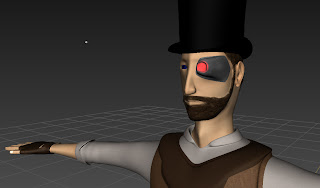This blog post is arriving a few days later than my usual Wednesday night timeframe, for reasons obvious to those that read the title (Exams). Most of my week was spent preparing for a multitude of exams while working a bit on some assignments and trying to get some asset creation done. I'm pretty sure I did OK on all my exams (at the very least a sixty percent; I tried to mark myself pessimistically so I could be pleasantly surprised). Enough about tests though, what everyone should be here for is to see the progress made on our game PIVOTal, which personally isn't too much because of, you know, Exams.
First things first, and update on my character model. Recently we started using Mudbox to add more detail and texture our low poly Maya models from previous weeks. I did some preliminary experiments with my character, but as this doesn't have to be handed in until the semester's end I can see that I will be trying to learn much more about what's possible and make the best model I can (hopefully 2 million poly's, super detailed, and professional quality). The tutorials have been really helpful and have taught me a lot of new tools that I can see will be very useful in my future.
 |
| Beware the Mud Man |





